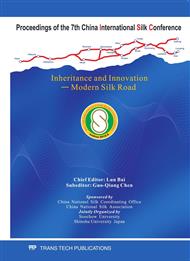p.272
p.276
p.280
p.284
p.288
p.294
p.299
p.303
p.308
Characterization and Properties of Antheraea pernyi Silk Finished with Reactive Quaternary Ammonium Salt of Chitosan
Abstract:
In order to obtain a water soluble and reactive chitosan derivative, quaternary ammonium salt groups and acrylamidomethyl groups were introduced to chitosan by two steps. The chitosan derivative, reactive quaternary ammonium salt of chitosan, was then applied to Antheraea pernyi (A. pernyi) silk by padding and curing method. FT-IR, XRD and SEM were used to characterize the structure of A. pernyi silk before and after treatment. The peak in FT-IR spectra at 1480 cm-1 and 1650 cm-1 revealed the crosslinking reactions of A. pernyi silk fibroin and reactive quaternized chitosan. The XRD results indicated the crystallinity of the treated silk fiber increase a little in comparison with the untreated ones. SEM images clearly showed the reactive quaternary ammonium salt of chitosan attached on the surface of the treated A. pernyi silk fiber, while the surface of the untreated sample was relatively smooth. The thermal stability of the treated silk fiber was enhanced compared to the untreated one by DSC analysis. It was also found that the antibacterial activity of the treated A. pernyi silk fabric against E. coli was more than 99%.
Info:
Periodical:
Pages:
288-293
Citation:
Online since:
January 2011
Authors:
Price:
Сopyright:
© 2011 Trans Tech Publications Ltd. All Rights Reserved
Share:
Citation:


